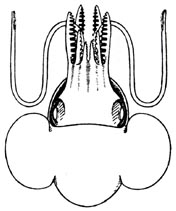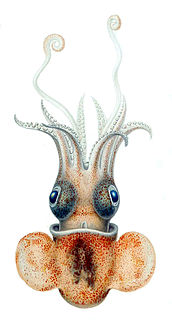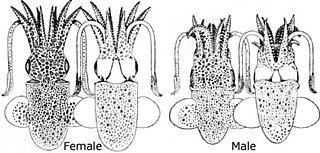
Rossia glaucopis is a species of bobtail squid native to the southeastern Pacific Ocean, specifically the waters around Chile.

Nectoteuthis pourtalesi is a bathybenthic species of bobtail squid native to the tropical western Atlantic Ocean, specifically Florida and the Antilles.

Stoloteuthis leucoptera, also known as the butterfly bobtail squid, is a widespread species of bobtail squid. Its natural range covers the Atlantic Ocean, Mediterranean Sea, and southwestern Indian Ocean. It is distributed from the Gulf of St Lawrence to the Straits of Florida in the western Atlantic and in the Bay of Biscay in the eastern Atlantic. In the Mediterranean Sea, it is specifically found in the northern and southern Tyrrhenian Sea, Ligurian Sea, and off Gorgona Island. S. leucoptera has also been recorded from the Benguela Current off Namibia. There exist unverified records of specimens off eastern Tasmania.

Austrorossia mastigophora is a species of bobtail squid native to western, southern and eastern Africa, from Guinea and Somalia to the Cape of Good Hope. A doubtful record of this species exists from Chile. It lives at depths to approximately 640 m.

Rondeletiola minor, also known as the lentil bobtail, is a species of bobtail squid native to the eastern Atlantic Ocean and Mediterranean Sea. Its natural range covers the northwest of Spain, Portugal, and the eastern, central and western Mediterranean Sea to the southeastern Atlantic Benguela Current off Namibia.
Sepia pulchra is a species of cuttlefish native to the southeastern Atlantic Ocean, specifically off the Cape Peninsula in South Africa. It lives at depths of between 15 and 50 m.

Sepiella cyanea is a species of cuttlefish native to the southwestern Indian Ocean, from Port Elizabeth and Durban north to central Mozambique (26ºN) and Madagascar. It lives at depths of 13 to 73 m.
Sepiola pfefferi is a species of bobtail squid native to the northeastern Atlantic Ocean. Specifically, it occurs on the continental shelf off the Faroe Islands and from southern Norway to Brittany in France. The depth range of this species is unknown.
Sepiola rossiaeformis is a species of bobtail squid native to the Indo-Pacific. Its exact range is unknown.
Euprymna hyllebergi is a species of bobtail squid native to the eastern Indian Ocean, specifically the Andaman Sea off Thailand. It is known from depths to 74 m.
Inioteuthis japonica is a species of bobtail squid native to the western Pacific Ocean, specifically the waters off China, Taiwan, and southern Japan.
Rossia brachyura is a species of bobtail squid native to the tropical western Atlantic Ocean, specifically the Greater and Lesser Antilles.
Rossia bullisi, also known as the Gulf bobtail squid, is a species of bobtail squid native to the tropical western Atlantic Ocean, specifically the northern Gulf of Mexico and Straits of Florida.
Rossia megaptera, also known as the big-fin bobtail squid, is a species of bobtail squid native to the northwestern Atlantic Ocean, specifically Davis Strait, western Greenland, and off New York, in Hudson Canyon. It lives at depths from 179 to 1,536 m. It can grow up to 41 mm in mantle length.
Rossia moelleri is a species of bobtail squid native to the northern Atlantic Ocean and the Arctic Ocean, eastward to the Laptev Sea and westward to Amundsen Bay. It occurs off western and northeastern Greenland, northeastern Canada, Labrador, Spitsbergen, Jan Mayen, and in the Kara Sea. R. moelleri lives at depths from 17 to 250 m.
Rossia mollicella is a species of bobtail squid native to the western Pacific Ocean, south from Sendai Bay, Japan. It occurs on the outer continental shelf and in the upper bathyal zone. R. mollicella lives at depths from 729 to 805 m.

Rossia palpebrosa, also known as the warty bobtail squid, is a species of bobtail squid native to the northern Atlantic Ocean.

Iridoteuthis iris is a species of bobtail squid native to the northern central Pacific Ocean; it occurs near the Hawaiian Islands off the southeast and northwest Hancock, Colahan, and Kammu seamounts. There exists a doubtful record from the Ceram Sea. Unlike most other bobtail squid, I. iris is pelagic and lives in the open ocean.

Neorossia caroli, the Carol bobtail squid, is a species of bobtail squid belonging to the family Sepiolidae.

Rossia is a genus of 10 species of benthic bobtail squid in the family Sepioidae found in all oceans. They live at depths greater than 50 m (164 ft) and can grow up to 9 cm in mantle length. This genus was first discovered in 1832 by Sir John Ross and his nephew James Clark Ross in the Arctic Seas, showing a resemblance to another genus under the same family, Sepiola. After returning from their expedition, Sir Richard Owen officially classified Rossia to be a new genus, naming it after Sir John and James Clark Ross.








